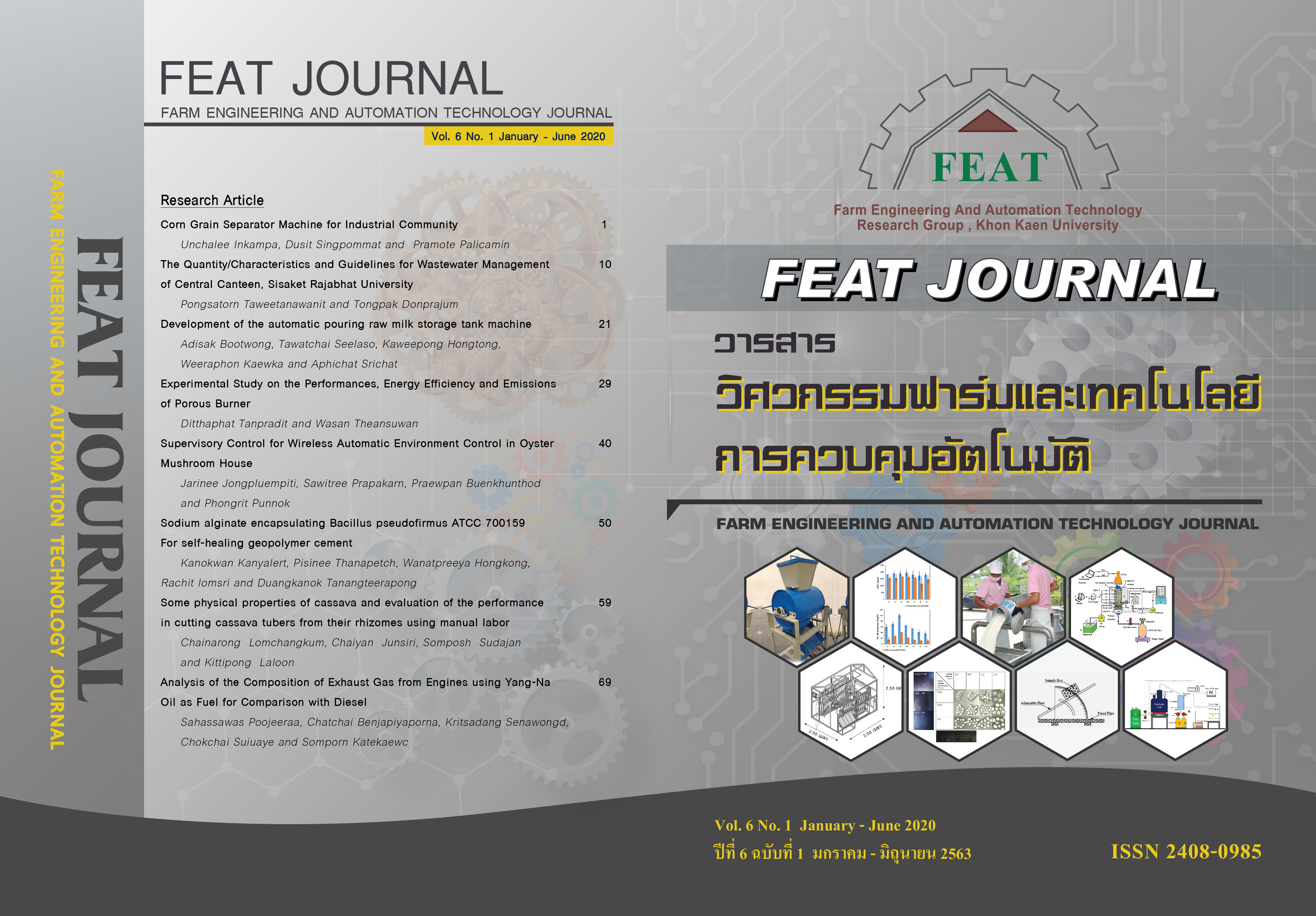Sodium alginate encapsulating Bacillus pseudofirmus ATCC700159 for self-healing geopolymer cement
Main Article Content
Abstract
A self-healing geopolymer containing encapsulated bacteria in alginate beads was successfully performed to protect high alkalinity during the geopolymer casting. In this study, Bacillus pseudofirmus was incubated for 5 days in broth medium and mixed with 0.5 % w/v sodium alginate before dropped through the 0.8 mm diameter needle by an extrusion technique. Afterwards, the encapsulated cells in alginate beads were immersed in 10, 11 and 12 M NaOH and total released cell numbers were counted by haemocytometer to determine the number of dead cells. It was found that the dead cells were 8.67±8.67%, 40.58±12.79%, 92.59±3.71% in 10, 11, 12 M NaOH solution respectively after being exposed for 80 minutes. However, the number of non-encapsulated dead cells reached the highest point within 20 minutes. Therefore, the encapsulation has proved to be able to protect cells by having an increase in the survival rate of Bacillus pseudofirmus in sodium alginate beads. The geopolymer containing these encapsulated beads by 10% and 20% showed no negative effects on the compressive strength according to Fisher’s exact statistic method (p<0.05).
Article Details
วารสารวิศวกรรมฟาร์มและเทคโนโลยีควบคุมอัตโนมัติ (FEAT Journal) มีกําหนดออกเป็นราย 6 เดือน คือ มกราคม - มิถุนายน และกรกฎาคม - ธันวาคม ของทุกปี จัดพิมพ์โดยกลุ่มวิจัยวิศวกรรมฟาร์มและเทคโนโลยีควบคุมอัตโนมัติ คณะวิศวกรรมศาสตร์มหาวิทยาลัยขอนแก่น เพื่อเป็นการส่งเสริมและเผยแพร่ความรู้ ผลงานทางวิชาการ งานวิจัยทางด้านวิศวกรรมศาสตร์และเทคโนโลยีพร้อมทั้งยังจัดส่ง เผยแพร่ตามสถาบันการศึกษาต่างๆ ในประเทศด้วย บทความที่ตีพิมพ์ลงในวารสาร FEAT ทุกบทความนั้นจะต้องผ่านความเห็นชอบจากผู้ทรงคุณวุฒิในสาขาที่เกี่ยวข้องและสงวนสิทธิ์ ตาม พ.ร.บ. ลิขสิทธิ์ พ.ศ. 2535
References
[2] Mostafa, S. and Aydin, B. (2016). Bioconcrete: next generation of self-healing concrete. Springer-Verlag Berlin Heidelberg, 2016.
[3] Ali, M.K., Abu-Tair, A.I., Kinuthia, J.M., and Ryszard, B. Self - healing and strength development of geopolymer concrete made with Waste by products. International Conference on Biological, Civil and Environmental Engineering, 2015.
[4] Subhash V. and Patankar. Effect of Sodium Hydroxide on Flow and Strength of Fly ash Based Geopolymer Mortar. SRES College of Engineering, Kopargaon, 2012.
[5] Evandro, M. Denis, P. Ramila, C. and Denis, R. (2017). Oil encapsulation techniques using alginate as encapsulating agent: applications and drawbacks, November 2017, pp. 5-15.
[6] Hana, Ž. Jií, P. Zuzana, R. and Pavla, R. (2019). Effect of bacteria Bacillus pseudofirmus and fungus Trichoderma reesei on self-healing ability of concrete, Czech Technical University in Prague.
[7] สกลวรรณ ห่านจิตสุวรรณ์, ธนากร ภูเงินขำ และ ปริญญา จินดาประเสริฐ (2556). Study physical property of fly ash geopolymer paste. วารสาร วิชาการคณะเทคโนโลยีอตุสาหกรรม มหาวิทยาลัยราชภัฏลำปาง, 6, มกราคม 2556.
[8] S. Petraityt and A. Šipailien, “Enhancing encapsulation efficiency of alginate capsules containing lactic acid bacteria by using different divalent cross-linkers sources,” Lwt, vol. 110, no. November 2018, pp. 307–315, 2019.
[9] S. Luhar, S. Chaudhary, and I. Luhar, “Thermal resistance of fly ash based rubberized geopolymer concrete,” J. Build. Eng., 2018.


